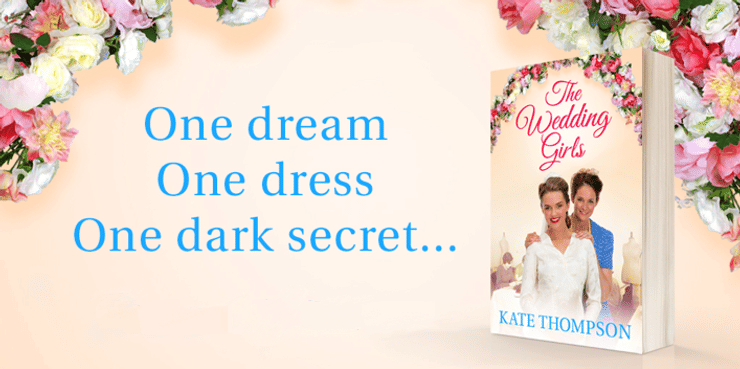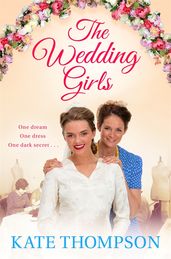Kate Thompson on how weddings have changed
Kate Thompson, author of The Wedding Girls, on how weddings have changed since the 1930s.

The bride wore vertiginous, pillar-box red Vivienne Westwood heels as she walked up the steps, not to a church, but a duck-egg blue beach house in Whitstable. Homemade bunting fluttered from the veranda and the brief exchange of vows was done with the backdrop of surf on shingle.
When my sister Nell chose to marry her fiancé Matt, with their 2-year-old son Ted as a pageboy she was making a clear declaration of her own individuality and style. Not for her the pastel-coloured world of the traditional white wedding. There was no cake-cutting ceremony, no elaborate seating plan, no honeymoon and most definitely, no fuss. Instead, we drank cold beers, and ate barbequed lobster in my brother's back garden. It was as perfect and unique as she is.
Nell is by no means alone in turning her back on the more formal elements of a wedding. Rock n Roll Bride, which promotes “individuality and general awesomeness” is now the fastest growing wedding blog in the world.
Hundreds of brides are eschewing the ways in which their mothers' and grandmothers' married, and tossing not just the bridal bouquet, but also the rulebook, out of the window. Hardly surprising when you consider the average age of a bride has risen from 20 in 1950, to 30 in 2017. Brides are older, wiser and more financially solvent than any generation before them.
Today, the UK wedding industry is worth a staggering £10 billion and the average wedding apparently costs £20,000. Flash-mob dances and a sun soaked fortnight in the Maldives don't cheap! But let's cast our mind back to a gentler era, a time when grooms didn't go on ‘epic' benders in Prague, and brides wore white as a symbol.
In researching my new novel, The Wedding Girls, set in a 1930s East End photography portrait studio, I uncovered a lost world of innocence, community and glamour.
The thirties and forties were the golden age of wedding portraiture. Glamorous weddings were a reaction to the horrors of the Great War and that, combined with the emergence of Hollywood, meant that women were determined to sprinkle a dusting of romance and escapism over the most important day of their lives.
These were the days when few people owned a portable camera, and formal studio portraiture was de rigueur across all classes. To own a beautiful wedding portrait – in a time when no one owned a camera, much less a selfie-stick, was a badge of honour. Divorce was unheard of back then. Women married firmly in the belief that it was for life, and as such the service was a deeply significant ceremony, a rite of passage.
I travelled my way around the East End to meet with many women, now in their nineties, whose memories and health might be fragile, but who still recall with vivid intensity the most treasured day of their lives.
‘Brian was just back from serving with the 7th Armoured Division, one of Montgomery's brave desert rats' when I met him at a dance,' recalls 88-year-old Rene, who was working as a 17-year-old shop girl in Petticoat Lane at the time. ‘He walked over to me and said, “I'm going to marry you”.' Rene's strict Jewish mother was less impressed. “Wait and see what he makes of himself first,” was her sage advice to Rene.
Brian knuckled down to civilian life and spent three years learning Hebrew so he could convert to Judaism in order to marry Rene. With her 22-inch waist and full crimson lips, Rene was so lusciously beautiful on her wedding day she could easily have passed for Rita Hayworth and her handsome bridegroom, Clark Gable.
It was difficult to distinguish shop girl Rene from screen siren Rita, and perhaps that is the point of a wedding gown? In stepping into a flowing white dress, a woman can transform herself into anyone she wants for the day.
I was so touched by the immense care each married couple took to look their best and the hope, resilience and pride shining out from their faces. The Second World War loomed darkly on the horizon. How many of these dashing bridegrooms I wondered, went on to fight and indeed survive that war?
We can never hope to recreate these spellbinding wedding portraits, or the chaste innocence that shines from them. Those times are long gone, but perhaps we can lose ourselves in them, if only for a little while.
The Wedding Girls
by Kate Thompson
It's 1936 and the streets of London's East End are grimy and brutal, but in one corner of Bethnal Green it is forever Hollywood. Tomboy Stella and troubled Winnie work in Herbie Taylor's photography studio on Green Street; their best friend and hopeless romantic Kitty is an apprentice dressmaker working tirelessly to create magical bridal gowns next door.
Community is strong on Green Street, but can it stand the ultimate test? As clouds of war brew on the horizon, danger looms over the East End. Will the Wedding Girls find their happy ever afters, before it's too late?
